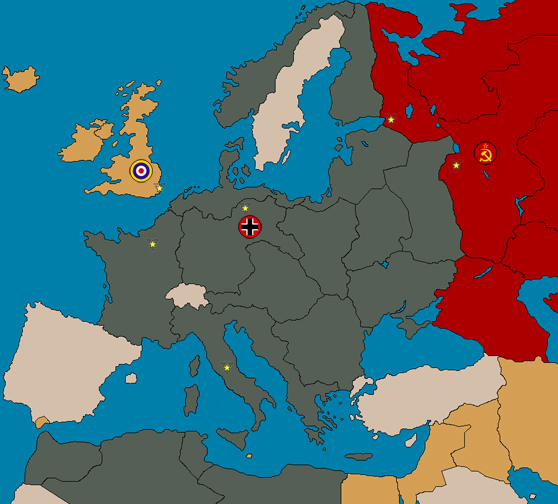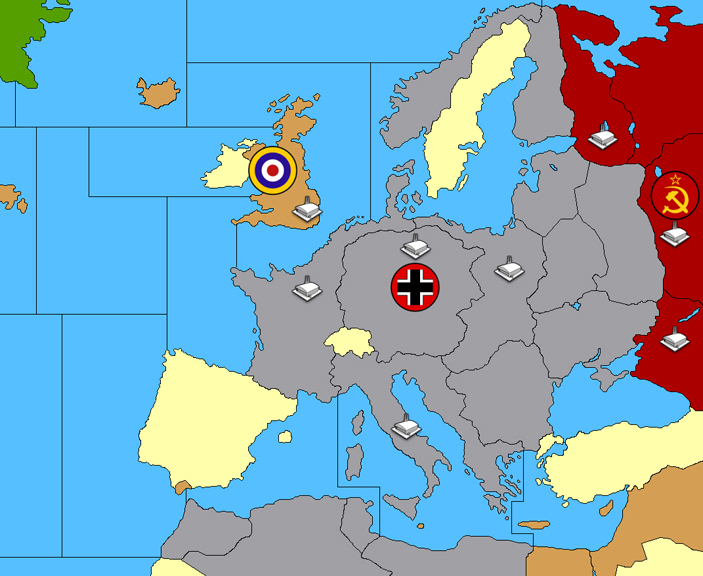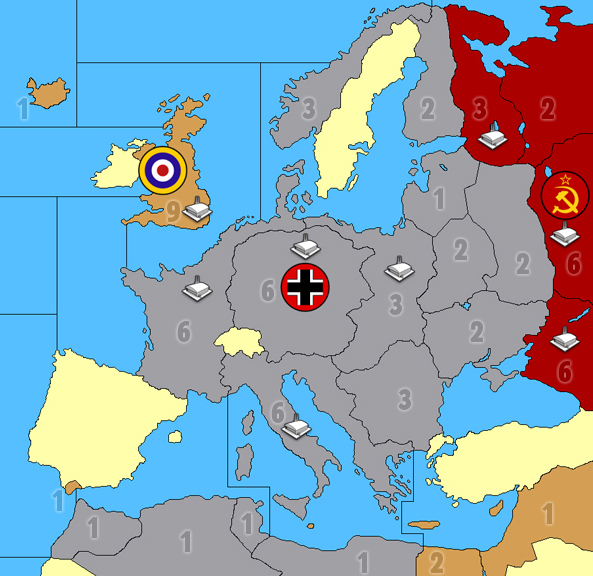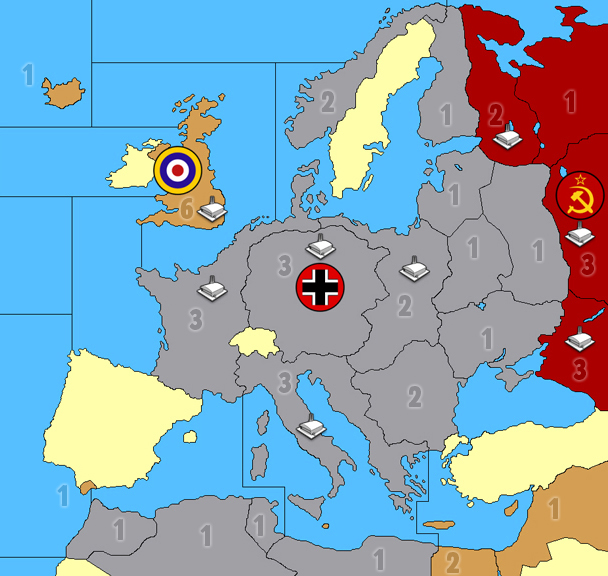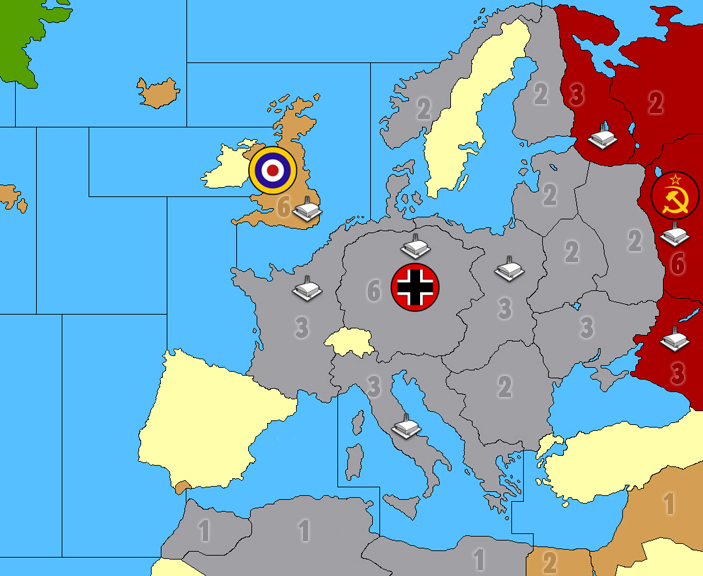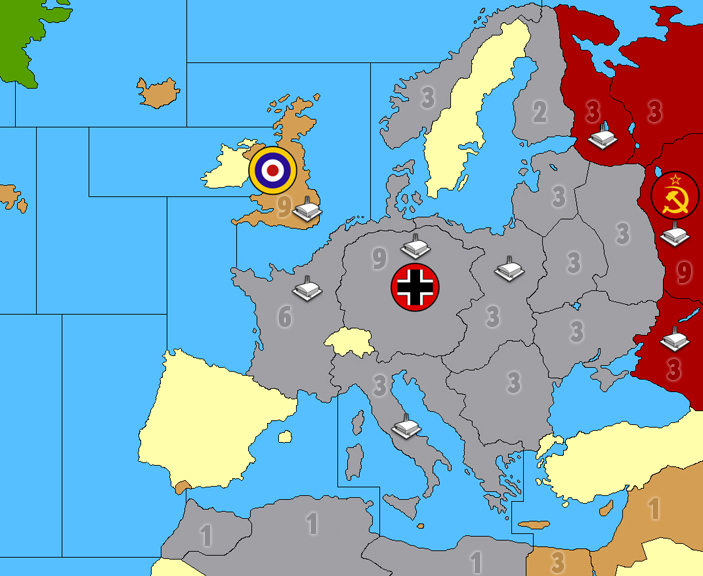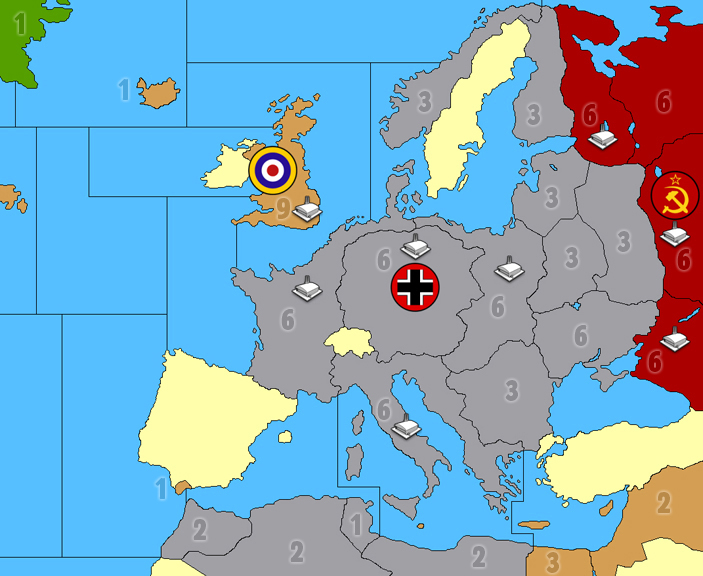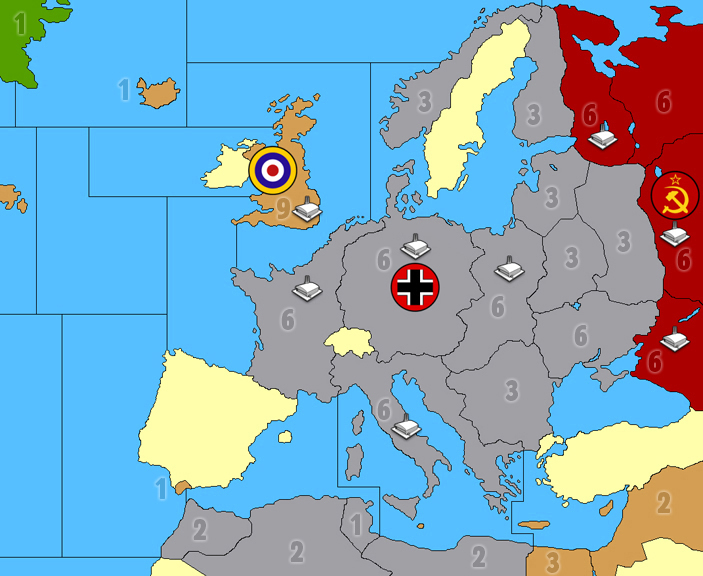Not sure I really see the dynamism of the current set up. Over several successive editions of Axis and Allies, I have seen more or less the same basic strategies play out with regard to capturing the German capital… And this despite several rather significant changes to the game, things like: sea zone and territory divisions around Europe, total production, total income, starting unit set up, unit cost and abilities, even turn order. All those things have changed in successive editions and yet the same basic dynamic occurs with respect to the fall of Berlin.
I see the point about trade-able territories, but have to admit the whole concept of France trading hands several times strikes me as a bit peculiar. I suppose in the abstract you can say that this trading just represents shifting lines at the front, but the game doesn’t actually model this. If Germany counter attacks an Allied stack in France and smokes it, its the equivalent of driving the Allies back into the see (not an Ardennes offensive contesting control of the boarder region with Germany.) I mean, I suppose my point would be, why not start with the more accurate representation, and then restore balance some other way, by other means? Adjust starting units, or total income for example.
I don’t see a major problem with the potential for Germany to stack defend with mass inf, so long as they are forced to split this inf over several target territories at the same time. This actually mirrors the historical reality. The problem with stack defense in the current game arises because Allies don’t have a way to effectively attack such stacks. Instead they are forced into a stack defense game of their own. Pushing with joint forces either from the West or the East (though east is often more effective since it allows all 3 allies to co-locate instead of just UK/USA.) I think this happens because the only coastal territory that truly matters is Berlin. The dynamic is such that, as Allies, you need to drop a large enough stack to both take a territory neighboring Berlin and then hold it against an overwhelming counter attack out of G… or baiting a counter attack strafe at odds, while retaining the option to assault Berlin on amphibious afterwards (if G takes too many hits.) This is basically how you establish a landing in the current game, and its much the same as its always been.
The problem is that G doesn’t have enough incentive to hold coastal territory outside Berlin, and every incentive to lightly trade it, fold into the Berlin ball and maintain income parity through constant trading light while stacking the core. UK and USA basically do the same, to maintain income parity, trading over and over until one side or the other breaks apart, or makes a critical error, at which point the game ends. Even in Global, with all the different things that were tried, Eastern Germany still plays much the same.
Put the question like this, say you did locate Berlin outside the threat of direct amphibious… In a game at the scale of 1942, which changes do you think would need to occur to accommodate it?
I see zombie’s suggestion as basically that G needs 10 production on a single sz, to facilitate a late game invasion of London. That seems reasonable enough. Why not make it France and Northern Europe together in sz 6, or 8, or even 5 rather than all in the Baltic? You could still get the same production concentrated into a single sz, I just don’t see why it has to come from the capital? France would allow for more flexibility to cover the Med, and be more important for G to hold, or the Allies to take.
I think MarineIguana, if I read you correctly, the thing that concerns you most is G’s ability to spam mass infantry over multiple factories over the course of the game from the very start. Just Max inf endlessly has long been a winning strategy for the Axis, and its true that its overpowered, but that is basically going to be the case with Germany no matter what. I would think the way to deal with that would be to put more production into contention in the area around G, so that Allies have an incentive to actually establish themselves on the continent at the coastal production locations, rather than just massing for amphibious on Berlin to end the game. Basically balanced on unit set up, from these conditions, rather than always around the Berlin shot out of sz5.
Would the map scale, or overall game scale need to be altered to accommodation such a change? Or could it be accomplished just with starting units and starting position?
Suppose there are other ways also that one might approach the sz 5 situation, perhaps by using rules for Straits like Gibraltar and Kattegat, but it just seems simpler to me to try a Berlin shifted off the coast approach using normal territory rearrangement, rather than more special rules for specialized territories.
It might be possible if you didn’t want to add territory, to just collapse them instead and adjust the border. If France and the Low Countries were brought back together with Denmark, the old Western Europe classic would now be worth 8 ipcs across basically the same territory. Then all you would have to do is stretch Baltic a bit further west, to make it a generic coastal region rather than specifically the states of Latvia, Estonia, Lithuania. Might work… if production was put on the two large coastal territories…
Or I guess you do a redesign of Poland, to bring it back into a broader Eastern Europe space more like Classic, to justify the production in the region. Basically 2 high priority targets/forward production centers, in place of 1 critical Capital as it is now. Even if you didn’t want to up the production too much but just split 6/6 between Western Europe and Eastern Europe, which would give you 12 total, without altering things too much…, sort of like this I guess, if you wanted it on sz 5.
You could shift the convergence point around depending on where you wanted it (maybe the Elbe?). In my experience Baltic States is rather small on the 1942.2 board, given the way it’s used. A larger space would help accommodate the many ground units in the ways which they are typically used. I mean how many territories are really needed around G anyway? I think 3 or 4 should be more than enough, probably even down to just 3 would be sufficient.
Consider also, the strategic interest if Eastern Europe and Western Europe could border each other by land. Meeting at the Elbe or the Oder. Imagine a Soviet push to Western from Eastern, or and Allied push to Eastern from Western. German rapid transition West/East or the other way around. I think it has the potential to be dynamic. Sz 5 would still be favored on naval, since that is likely be the best place for the two sz spaces to converge, near Denmark (on one side or the other.) Although it could also conceivably be a convergence in sz 6, which would put a lot more pressure on UK (that’s sz 8 and sz 5 each with six production, and a 12 drop where they come together in sz 6. Or you could just keep the convergence point in sz 5, since the baltic was historically more secure. Either way, the pressure on G to hold these factory territories and cover them as long as possible would be high, and might be a reasonable trade off for the benefits they gain in forward positioning. The flexibility from the production and position would likely go both ways, or at least, maybe it could be made too with proper starting unit placement.
It might be possible to collapse back into a southern Europe territory as well, basically creating a halo of 6 ipc territories around Central Europe Berlin, such that Germany is always pulled in 3 directions out of the capital. Or forced to choose which pair out of the 3 to cover at any given time East, South and West. Then for the Allies the goal would be to break off one of the 3 halo spaces and secure it. I envision a game were Germany is first encircled before being crushed. Three Allies each with 1 optimal target factory, Russia to Eastern Europe, Britain and America to Western and Southern. Germany would have a strong reason to defend on the front line, but also a strong reason to hold at the center to launch counter attacks in case one of the three halo spaces falls. So it’d be a trade off I think, stronger forward position but also more vulnerability.

